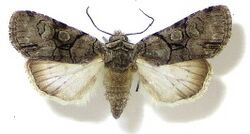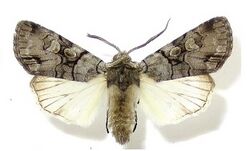Biology:Sympistis forbesi
| Sympistis forbesi | |
|---|---|

| |
| Female | |

| |
| Male | |
| Scientific classification | |
| Domain: | Eukaryota |
| Kingdom: | Animalia |
| Phylum: | Arthropoda |
| Class: | Insecta |
| Order: | Lepidoptera |
| Superfamily: | Noctuoidea |
| Family: | Noctuidae |
| Genus: | Sympistis |
| Species: | S. forbesi
|
| Binomial name | |
| Sympistis forbesi Zacharczenko & Wagner, 2014
| |
Sympistis forbesi is a moth of the family Noctuidae first described by Brigette Zacharczenko and David L. Wagner in 2014.[1] It has been recorded from the US states of Iowa, Illinois and Minnesota and is believed to be extirpated from the eastern portion of the range in New York and New Jersey.
The length of the forewings is 14.5–16 mm for males and 14–16.5 mm for females. The ground colour of the forewings is warm gray. The hindwings are pearly white with a thin terminal. Adults are on wing in late summer in one generation per year.
The larvae feed on Triosteum species, including Triosteum perfoliatum and possibly Triosteum aurantiacum. They are green with a reddish dorsum.
Etymology
The species is named in honour of William Trowbridge Merrifield Forbes.[2]
Gallery
Middle instar larva
Last instar larva on a flower of Triosteum perfoliatum
References
- ↑ "931906.10 – 10067.1 – Sympistis forbesi Zacharczenko & Wagner, 2014". Mississippi State University. http://mothphotographersgroup.msstate.edu/species.php?hodges=10067.1.
- ↑ "A new cryptic Sympistis from eastern North America revealed by novel larval phenotype and host plant association (Lepidoptera, Noctuidae, Oncocnemidinae)".
Wikidata ☰ Q16759178 entry
 |







